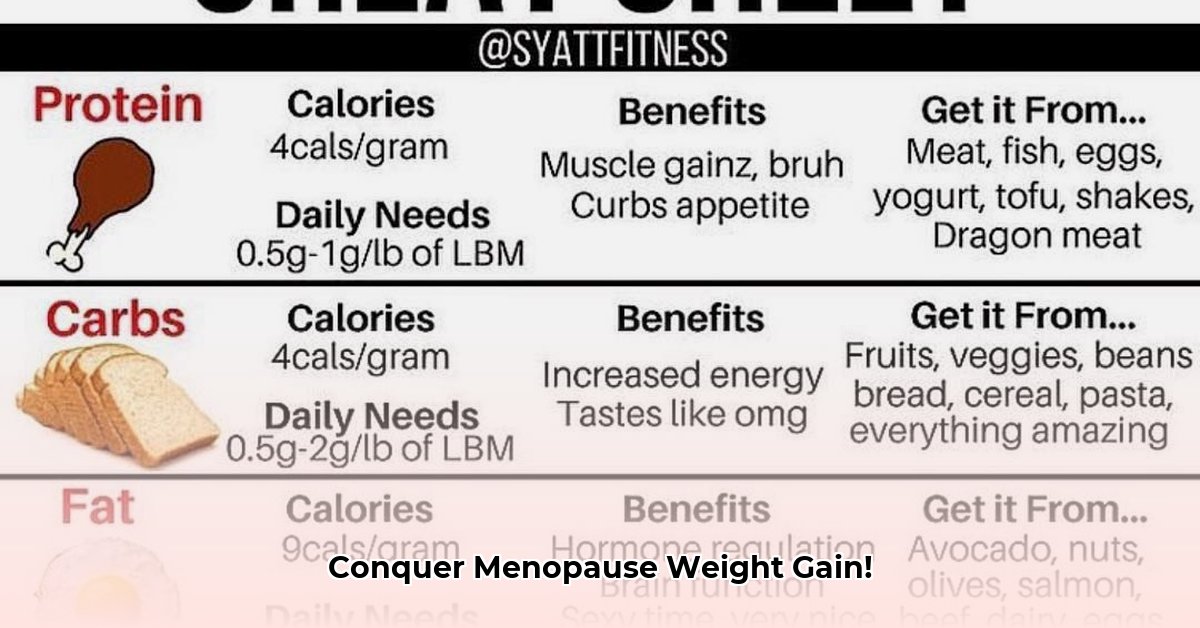
Menopause brings significant changes, and weight gain is a common, frustrating challenge. But understanding macronutrients—protein, carbohydrates, and fats—can empower you to take control. This guide provides a step-by-step approach to using macros for effective and sustainable weight loss during and after menopause.
Understanding Your Body's Shifting Landscape During Menopause
Menopause triggers hormonal shifts impacting metabolism and body composition. Decreased estrogen levels can lead to reduced muscle mass and increased fat storage, particularly around the midsection. This is a common experience, but it's not insurmountable. Adjusting your diet to account for these changes is key to successful weight management. What are macros? Simply the protein, carbohydrates, and fats in your food. Finding the optimal balance is crucial for sustainable weight loss.
Why Macros Matter: Fueling Your Body Right
Think of your body as a machine; during menopause, its efficiency might change. The right fuel—the correct macro balance—keeps it running smoothly.
Protein: Essential for muscle building and preservation, boosting metabolism, and maintaining strength—all crucial as we age. Good sources include lean meats, beans, lentils, Greek yogurt, and tofu. Increasing protein intake is often recommended during menopause. Did you know that adequate protein intake can increase your metabolic rate by up to 15%?
Carbohydrates: Provide energy. Choose complex carbohydrates—whole grains, fruits, and vegetables—over simple sugars. Complex carbs offer sustained energy release, keeping you feeling fuller longer. What percentage of your daily calories should come from carbohydrates? That depends on your individual needs and goals, but generally, a balanced intake is recommended.
Fats: Healthy fats are vital for hormone production and satiety. Focus on avocados, nuts, seeds, and olive oil. They help regulate hormones and prevent energy crashes. Are you incorporating enough healthy fats into your diet? Many women find that adding healthy fats helps manage hunger and cravings.
A personalized macro plan fuels your body effectively, supporting your weight management goals. This isn't about restriction; it's about nourishing your body during this life stage.
Crafting Your Personalized Macro Plan: A Tailored Approach
There's no one-size-fits-all macro ratio. The ideal balance of protein, carbohydrates, and fats depends on age, activity level, and overall health. A registered dietitian or nutritionist can create a personalized plan, but here are general guidelines:
- Assess Your Needs: Note your weight, activity level, and any health conditions.
- Calculate Calorie Needs: Use an online calculator (consider factors like age, height, weight, and activity level). These calculators provide estimates that should be adjusted based on your results.
- Set Realistic Goals: Aim for a gradual weight loss of 1-2 pounds per week.
- Experiment with Ratios: A starting point for many women is 30-35% protein, 30-35% carbohydrates, and 30-35% healthy fats.
- Track Your Progress: Use a macro-tracking app to monitor intake and fine-tune your plan based on your body's response. What's your preferred method for tracking macros? Many people find apps with visual representations particularly useful.
- Listen to Your Body: Adjust your plan based on hunger, energy levels, and overall well-being. Did you know that paying attention to your body's hunger cues is just as important as tracking your macros?
Remember to consult a healthcare professional before making significant dietary changes.
Tracking Your Progress: Monitoring Your Success
Consistent monitoring is vital. Macro-tracking apps simplify this process, allowing you to review intake, identify areas for improvement, and refine your plan. Remember, it's a journey, not a race. Celebrate your progress; every step counts.
The Importance of Exercise: A Holistic Approach
Exercise is crucial. Strength training combats muscle loss and improves bone density. Aim for at least two sessions per week. Complement this with moderate-intensity cardio for cardiovascular health. This approach supports long-term success. How often do you prioritize strength training in your exercise routine? Many studies highlight its importance for menopausal women.
Making It Sustainable: Creating Lifelong Habits
Sustainable weight loss is about lasting lifestyle changes. Prioritize whole, unprocessed foods, practice mindful eating (paying attention to hunger and fullness cues), and manage stress for overall well-being. This holistic approach is key for lasting results.
Potential Challenges and Solutions: Addressing Common Hurdles
Addressing common challenges is key to maintaining momentum.
| Challenge | Solution |
|---|---|
| Difficulty tracking macros | Start small, gradually increasing tracking frequency. Use a food scale and app. |
| Feeling overwhelmed | Break down goals into smaller steps. Consider professional support. |
| Lack of time for meal prep | Prep meals in advance. Use quick, healthy recipes. |
| Social challenges | Communicate goals to friends and family; seek support from like-minded individuals. |
Remember, consistent effort and a holistic approach are crucial for lasting results. Your journey towards a healthier, happier you is within reach.